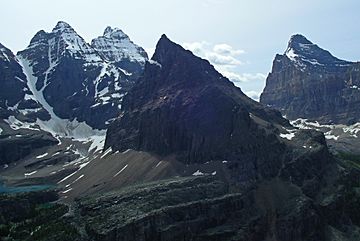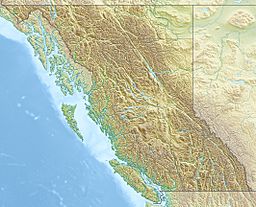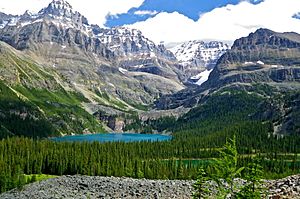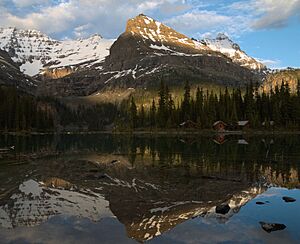Yukness Mountain facts for kids
Quick facts for kids Yukness Mountain |
|
|---|---|

Yukness Mountain (center) with Ringrose and Hungabee to left and Biddle to right
|
|
| Highest point | |
| Elevation | 2,851 m (9,354 ft) |
| Prominence | 161 m (528 ft) |
| Parent peak | Ringrose Peak (3292 m) |
| Listing | Mountains of British Columbia |
| Geography | |
| Location | British Columbia, Canada |
| Parent range | Canadian Rockies |
| Topo map | NTS 82N08 |
| Geology | |
| Age of rock | Cambrian |
| Type of rock | sedimentary rock |
| Climbing | |
| First ascent | 1918 Survey Party |
| Easiest route | Scramble |
Yukness Mountain is a tall peak, standing 2,851 meters (9,354 feet) high. You can find it in Yoho National Park in British Columbia, Canada. It's part of the Canadian Rockies and sits southeast of the beautiful Lake O'Hara. The closest taller mountain is Ringrose Peak, about 1 kilometer (0.6 miles) to its east.
Contents
History of Yukness Mountain's Name
In 1894, a person named Samuel E.S. Allen gave the mountain its name. He called it "yukness." This word comes from the Stoney language. It means "sharpened with a knife." This name fits because the mountain looks like a knife-edge when you see it from Lake O'Hara.
A writer named Walter Wilcox explored the area. He wrote about Lake O'Hara and Yukness Mountain. He described the lake as "beautiful." He also mentioned the "immense walls" and "cliffs" around it. He called Yukness a "pyramidal peak." He said it was at the base of a small lake. This small lake was behind a glacial dam.
First Climbs and Official Naming
The first time people climbed Yukness Mountain was in 1918. This climb was done by a survey team. They were mapping the area.
The mountain's name became official in 1952. The Geographical Names Board of Canada approved it. Before that, it was sometimes wrongly called Mount Yukness.
How Yukness Mountain Was Formed
Yukness Mountain is made of sedimentary rock. This type of rock forms from layers of sand and mud. These layers were laid down over millions of years. This happened during the Precambrian to Jurassic periods. At that time, the area was covered by shallow seas.
Later, a huge event happened. It was called the Laramide orogeny. This event pushed the sedimentary rock layers. They were pushed up and over younger rocks. This is how the mountain got its shape.
Climate Around Yukness Mountain
Yukness Mountain is in a subarctic climate zone. This means it has cold, snowy winters. The summers are usually mild. Temperatures can drop very low. They can go below -20 degrees Celsius (-4 degrees Fahrenheit). With wind chill, it can feel even colder. It might feel like -30 degrees Celsius (-22 degrees Fahrenheit).
Water from the mountain drains into Lake O'Hara. From there, it flows into the Kicking Horse River. This river then joins the Columbia River.





